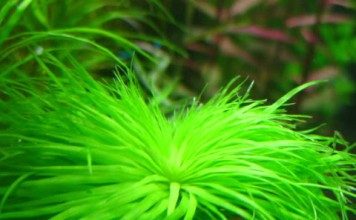Aponogeton madagascariensis is a very popular decorative aquatic plant among the aquarium enthusiasts mainly due to its novel skeleton-like appearance. It is native to the Islands of Madagascar off the southeast coast of Africa, but it is also found in Asia and Australasia. It is a fully aquatic plant; many African species grow in temporarily still or flowing waters and live through the dry period by shading their leaves as a dormant tuber. Most Asian species can survive submerged condition all year round.
It is a perennial aquatic plant with tuberous rhizomes. The leaves are lattice like without flesh between the veins which form a network of veins and tissue. It makes an ideal candidate for the mid-ground or foreground of the planted aquarium. The leaves are oblong which can grow to a height of 25-50 cm and a width of 30 cm. The leaves spread horizontally beneath the surface of the water. Madagascar Lace grows towards the top at an average rate. This plant prefers bright lighting in combination with soft, acidic water. The ideal position for this plant in your aquarium is in the center, helping you create a unique aquarium design. It produces flowers and the flower stalks rise above the water to show off their blossoms. The flower can do pollination under right condition and give rise to clusters of small green horn-shaped fruits after a few weeks. Propagation occurs through bulb separation or formation of seeds after flowering. After all, this plant is ideal for all aquariums because it keeps your tank healthy, more stable. It also makes your fish healthier and happier too.
Scientific name: Aponogeton madagascariensis
Common name: Madagascar lace, , Lattice Leaf, Lace Plant
Origin: Madagascar, Africa
Placement: Mid-ground
Propagation: Bulbs, seeds
Height: 30-60+ cm (12-24 inch+)
Water pH: 5.5-7.5
Water Hardness: 2-15 dGH
Temperature: 68-720 F (20-220 C)
Lighting: Medium
Growth: Fasts
Care level: Difficult







Aponogeton madagascariensis is a very popular aquarium plant with netted looking dark green leaves. Its lacy leaf structure is unique which gives the common name Madagascar lace. This species makes a beautiful centerpiece for any aquarium. Aponogeton is the only genus of 45-50 species of flowering plants in the family Aponogetonaceae. This plant has made a challenge to hobbyists due to extinction in its natural habitat in Madagascar since the 1950s. At present it is cultivated in the aquarium trade. It belongs to the family Aponogetonaceae under order Alismatales of Angiosperm groups. There are 4 varieties of Madagascar Lace plant. These are narrow leaved variety called Aponogeton madagascariensis var. guillotii; Aponogeton madagascariensis var. fenestralis, and Aponogeton madagascariensis var. henkelianus. Synonyms of this species are Aponogeton fenestralis and Uvirandra madagascariensis Mirb.
Aponogeton madagascariensis is one of the most highly prized plants in the hobby. It requires a tank with clean and clear water conditions. The tank should have a high filtration system with strong water flow along with soils low in organic matter. Nutrient rich substrates or those with added peat or manure should be avoided. It is best kept in soft water with a pH of 5.5-7.5, hardness of 2-15 dGH and a temperature of 68-720 F (20-220 C). Lighting should be medium in the range of 3 to 5 watts per gallon, using full spectrum (5000-7000K) bulbs. This plant requires CO2 additions to do its best, along with careful maintenance of all micronutrients and macronutrients. The lace plant is especially sensitive to a lack of soluble iron in the water. Older leaves get brown spots which makes them rather less attractive to look at. In this case trim any dead or older leaves to make an attractive aquarium. Sometimes dead spots are seen on the leaves which indicate that the soil is too rich in the plant. Do not allow algae growth or any other debris to settle on or within the leaves. Algal growth is difficult to remove from the leaves. In this case, algae eating fish is suitable to control the overgrowth of algae. Madagascar Lace Plant should be planted singly in the mid-ground part of the aquarium among the other plants because roots from other plants help the lace plant get established. Ideally, these ‘companion plants’ should not overgrow or shade the lace plant leaves.



Aponogeton madagascariensis is the queen of aquarium plants. It is popular decorative plant among the aquarium enthusiasts due to its beauty and dark lace like structure. It provides an extra attractive feature in the aquarium as a mid-ground or foreground plants. This gorgeous plant is available in many local pet fish shops and online vendor. If your looking to purchase Madagascar Lace today, check out below where you can buy it!
It can propagate easily in aquarium condition with proper care. It occurs through bulb separation or formation of seeds after flowering. During planting from a bulb or tuber, it should be pushed into substrate for a few weeks, leaving the half of the growing tip above the substrate until the roots are established. Allow the new plant to develop a more root system and immature leaves separate from the mother plant and it should be planted in a different location. It can also do sexual reproduction through seed production. If seeds are produced, it disperses away from the parent plant. After floating for a day or two, the seed coat becomes clear and waterlogged and splits open to release the green embryo inside, which sinks to the bottom. In bottom condition seeds can do germination and after a few days it produces seedlings. To enhance germination the tank needs lots of water changes. They also need a nutrient rich substrate.
In the market for some Madagascar Lace? well we are now selling it right here on Aquatic Mag. You can can also get a 10% off discount just by sharing this post.
Aquarium Plants
by Aquatic Mag Time to read: 5 min